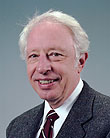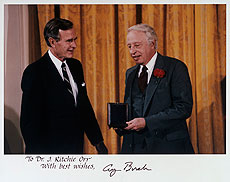In Memoriam: J. Ritchie Orr - Nov. 3
 |
|
Rich Orr
|
Rich Orr, former Fermilab associate director, died on Thursday, Nov. 3. He is survived by his wife, Suzanne.
Orr started at Fermilab as a physicist in 1970, after receiving a Ph.D. in physics at the University of Washington. He participated in the construction of the Meson Lab in the early 1970s, and he eventually became the project manager for the Tevatron. During his career, Orr worked in several different Fermilab departments.
"There was hardly a job at Fermilab that Rich didn't do at one time or another," said John Peoples, former Fermilab director.
No matter what task he was tackling, Orr handled it with poise.
"Rich was just great," said Peter Limon, a retired Fermilab physicist who was hired by Orr in 1972. "He knew how to keep calm and keep you calm."
Orr's composed demeanor certainly added to his management skills, especially when it came to focusing on what seemed like an incredible task.
"Rich Orr and Helen Edwards were the most incredible team ever assembled at Fermilab," said Roger Dixon, head of the Accelerator Division. "They accomplished what seemed impossible to many of us. They built the Tevatron."
In 1989, Orr was one of four Fermilab scientists to receive the National Medal of Technology for his contributions to the creation of the Tevatron. The medal was presented by President George H.W. Bush to Orr, Edwards, Richard Lundy and Alvin Tollestrup.
"It was a critical time of getting the Tevatron together," Edwards said. "Rich did a great job of focusing everyone and orchestrating the whole thing. He was something special."
Tollestrup agreed.
"Rich was exceedingly important in pulling the project together," Tollestrup said. "For the Tevatron, he was out in front."

Rich Orr receiving the National Medal of Technology from President George H.W. Bush in 1989.
Even with the personal responsibilities that come with being the face of a high-profile project, Orr always made the people on his team his first priority.
"There was tremendous pressure-we were building the Tevatron," Limon said. "And he made everybody feel better. He made things work."
According to both Edwards and Limon, the buck stopped with Orr. He worked to protect colleagues by handling the particularly difficult problems himself. He did not pass responsibility or blame, and he diplomatically encouraged his team.
"Rich knew about people. He knew how to make you feel good about yourself and motivate you to contribute in the best way," Limon said. "He'd correct you, but he'd never condescend."
Dixon called Orr a natural born leader and organizer.
"Rich brought incredible skills to the job," Dixon said. "I tried to learn as much as I could from every time I was around him."
After his retirement in 1991, Orr moved to Port Angeles, Washington with his wife. He continued to do small consulting jobs for several laboratories across the country. But he took the time to enjoy life and spent most of his time exploring the local woods and beaches with Suzanne.
Limon described the loss and sadness experienced by those who knew Orr concisely.
"Boy, I miss him," Limon said.
—Ashley WennersHerron
|